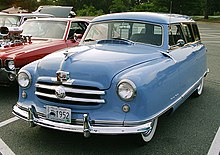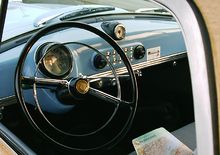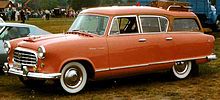Nash Rambler
The Nash Rambler was a US automobile manufactured by Nash Motors , the automotive division of Nash-Kelvinator Corporation , from 1950 to 1956.
development
The Nash-Kelvinator Corporation chairman, George Walter Mason , realized that the company needed to bring more competitive models to market and insisted that a new car had to be different from the models on the market. The Rambler was designed to be smaller than most contemporary American cars, but also had room for five people. The Nash Rambler created a new segment in the automotive market and is widely regarded as the first modern American compact car .
During the development, the vehicle was originally given the name Diplomat at Nash . This name would have gone well with the previous models, as the "600" was called Statesman from 1950 and the Ambassador was the brand's flagship. But Dodge had already reserved that name for a planned two-door coupe, so Nash remembered his past and revived the 1902 Rambler name . The Rambler was one of the most popular American cars at the time. The new Nash Rambler was also highly regarded throughout its production period 1950–1956.
1950-1952
The Nash Rambler was introduced in the 1950 model year. It was the brand's contribution to the so-called low-price segment, which was dominated by the models from Chevrolet , Ford and Plymouth . The Rambler was lighter and smaller than other popular cars. This enabled Nash to save material in production, and customers benefited from the lower fuel consumption. The car had a wheelbase of 2540 mm and was powered by a proven in-line six-cylinder engine with a 2.83 ltr. Displacement and L-Head (side valves) driven, which developed 82 SAE-PS (61 kW).
The new Rambler was also introduced as a classy 2-door convertible - known as the " Landau ". The decision to offer this car model in a higher market segment with better equipment was a carefully considered one by Mason. First of all, he wanted to give the new Rambler a positive image. Mason knew the car would fail if customers saw it as a “cheap little car”. He already knew what Crosley was only just discovering about his series of mini cars and what the Kaiser-Frazer Corporation still had to learn from his Henry J model : Americans would rather buy a beautiful used car than a new vehicle that is said to have a low standard .
Other factors that played a role in the marketing strategy for the Rambler were the reduced steel supply caused by the Korean War and Nash's strategy of maximizing profits. The desire to achieve the highest possible profit on sales meant that the Rambler was significantly higher in price than the base models of the competition, given the low production figures expected at the beginning. To add value to buyers, the cars were very well equipped, e.g. B. with whitewall tires , complete wheel covers, electric clock and an AM radio with push buttons.
Just like the larger Nash models, the compact Rambler had rounded shapes and a pontoon body with complete wheel covers that also included the front wheels. However, this equipment did not affect the turning circle of the car too much. Contrary to the custom of frameless side windows for convertibles at the time, the Rambler had a fixed roof structure over the doors and side window frames. These metal structures served as guide rails for the opening, watertight hood. This construction enabled Nash to use his monocoque body for the new compact car. It made the Rambler very torsion-resistant for an open car, without the additional body stiffeners required for other convertibles.
In 1951 the Rambler series was expanded to include a 3-door station wagon and a 2-door hardtop coupé. This was called the Country Club .
1953-1955
In 1953 the Rambler was revised for the first time and looked very similar to the larger Nash models that had received the new "Airflyte" styling in the previous year. A 2-door sedan was also offered from 1953. In 1954 a 4-door sedan and a 5-door station wagon - called "Cross Country" - were added. The 4- and 5-door models had a wheelbase of 1743 mm. From 1955 the front wheel cutouts were no longer covered.
On January 14, 1954, Nash merged with Hudson Motor Car Co. to form American Motors Corporation (AMC). Subsequently, the Ramblers were also offered as the Hudson Rambler at dealers of this brand. Both models were identical.
1956-1957
For 1956 American Motors designed a brand new Rambler. They chose a wheelbase of 2743 mm, and the vehicle became longer. Again the Rambler was sold as a Nash and a Hudson. It was only available with 4 and 5 doors. In addition to the sedan and station wagon, a new, 4-door hardtop sedan was also offered. In addition, the Rambler was the first car that was available as a hardtop station wagon. 1957 Rambler became an independent brand; the names Nash and Hudson were dropped. V8 engines were also available in the Rambler from 1957. It was the 4.1-liter engine developed by AMC, which was introduced the year before in the Nash Ambassador Special and the Hudson Hornet Special. Only in 1957 was a special high-performance hardtop sedan called the Rambler Rebel offered. This car had the new 5.4 liter V8 engine from AMC. This machine was also used in the company's larger cars, the Nash Ambassador and the Hudson Hornet of this year. It was planned to equip the Rebel with manifold injection , but cold start problems prevented this operation in the last minute. The Rebel, which was only produced in small numbers (1,500), was a forerunner of the muscle cars that became popular in the 1960s.
After 1957
From 1958 Rambler was the only brand of American Motors Corporation after the Nash and Hudson brands were given up. The smaller model was now offered as the Rambler American , the larger model introduced in 1956 was initially called the Rambler Six (or Rambler V8), and from 1961 onwards the Rambler Classic .
Nash Rambler in popular culture
In 1958 the music group The Playmates wrote a song entitled "Beep-Beep" in which the driver of a Nash Rambler downplayed the song's "narrator", a Cadillac driver. The song was a brief hit and has been featured more frequently in Dr. Demento radio show played.
The Nash Rambler plays a central role in Kaizo Hayashi's Hama trilogy The Most Terrible Time of My Life , Stairway to the Distant Past and The Trap . These films show Masatoshi Nagase as Maiku Hama, the police inspector. The die-hard - but nonetheless overly hip - detective drives a two-tone Nash Rambler convertible through the streets of Yokohama . The Nash almost himself plays a role in these films: e.g. For example, in Stairways to the Distant Past he takes on a case himself and retrieves his “little car” from loan sharks.
Also in Saturday Night Live, sketches of the "Church Lady" ( Dana Carvey ) drive a Rambler, even if Satan ( Jon Lovitz ) does not say which one.
swell
- Gunnel, John (editor): The Standard Catalog of American Cars 1946-1975 , Kraus Publications (1987), ISBN 0-87341-096-3 .




